From The Tallgrass To The Forest: The George Washington and Jefferson National Forest
By Alex Demas, Office of Communication
Editor's note: The following article was provided by the U.S. Forest Service.
Sunlight dapples through the verdant forest canopy above you. A gentle breeze cools the late summer warmth. Occasional white blazes peeking from trees reaffirm you’re going the right way. Flame-colored Canada lilies hang shyly, waiting patiently for discovery just off the trail path, while birdsong swells for all denizens of this green tunnel to enjoy. Then, you turn a corner, the forest opens, and a spectacular view unfolds. The lush valleys rise to rolling stacks of rounded mountains, each offering a different shade of golden-green against the perfection of a blue, humid sky. This natural beauty sits within the George Washington and Jefferson National Forest, the heartland of the Appalachian Trail.
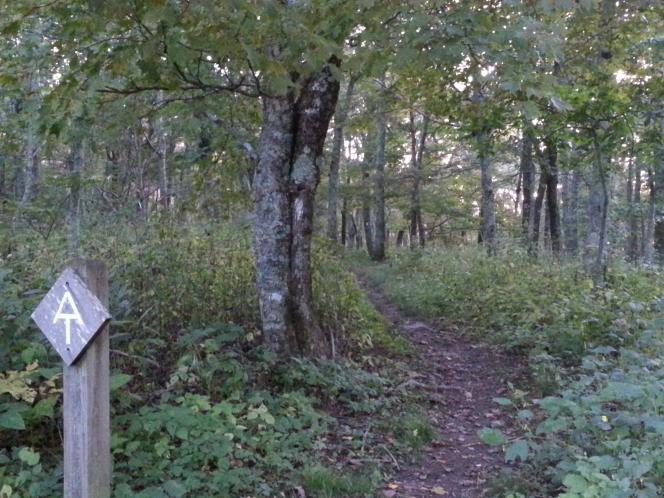
The Appalachian Trail is marked by white blazes and signs with the A.T. logo like this one in the Thunder Ridge Wilderness of the George Washington and Jefferson National Forest/U.S. Forest Service
Stretching along the border of Virginia and West Virginia, the George Washington and Jefferson National Forest blankets the Blue Ridge mountains, which were old even when dinosaurs roamed the Earth. These forests encompass more than 1.7 million acres of mountain and valley, with more wildlife and hiking trails than you can explore in a lifetime. While every route on the forest carries visitors to new memories, 325 miles of the famed Appalachian National Scenic Trail are found here.
Heart Of The Trail
Known as the A.T. by its devoted fans, the Appalachian National Scenic Trail runs from Georgia to Maine, with many storied stretches and viewpoints. But for USDA Forest Service Recreation Program Manager Matthew Helt, the section that runs through the George Washington and Jefferson National Forest is the beating heart of the trail.
“I like to think of the trail as a web, connecting all these sections together: the stretches in Smoky Mountains and Shenandoah National Parks, the long paths through our sister national forests in Appalachia, not to mention all the state parks and private landowners,” he explained, pointing to the sprawling map of the A.T.’s length. “But here on the George Washington and Jefferson National Forest, we’ve got the longest single stretch and we’re right in the middle, the center of the web.”
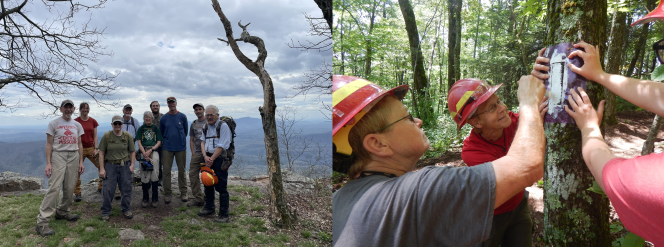
Volunteers are vital for maintaining the A.T. On the left, volunteers from the Natural Bridge Appalachian Trail Club worked with staff from the Appalachian Trail Conservancy and the Forest Service to plan trail rehabilitation, installing rock stairs and managing drainage to mitigate erosion. On the right, volunteers from the ATC’s Konnarock Trail Crew paint the famous white blazes on a tree to mark the A.T.’s path/Images courtesy of the Appalachian Trail Conservancy.
And Helt isn’t the only one that loves the A.T. on the George Washington and Jefferson National Forest. No fewer than eight A.T. trail clubs volunteer their time, money and effort on the A.T., and in 2023, devoted more than 27,000 hours to it. Forest Service employees work with these volunteers to plan projects, assess needs and deploy assets to ensure the A.T. remains one of the most well-maintained trails in the world.
Kathryn Herndon-Powell, the Central Virginia regional manager for the Appalachian Trail Conservancy, shares their devotion.
“The Appalachian Trail in the George Washington and Jefferson National Forest is a world-class hiking experience, whether you're on a windswept summit or winding through a lush mountain cove. That experience is protected by the land itself – I'm so grateful we have this vast, intact forest here in Virginia – as well as the faithful stewardship of a vibrant community of partners,” she said. “Coordination and support from the George Washington and Jefferson National Forest makes it all possible.”
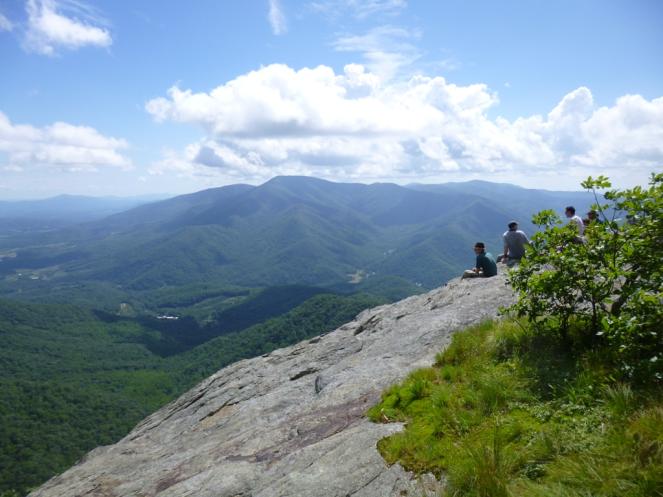
While hiking along the A.T., there is no end of amazing places to take a break and enjoy a spectacular view. This is the Hanging Rock in the Three Ridges Wilderness of the George Washington and Jefferson National Forest/U.S. Forest Service
Trails specialist Megan Martin, recognized as 2024 Appalachian Trail Conservancy Virginia Regional Partnership Committee’s Partner of the Year, understands better than anyone how to weave collective stewardship into the landscape.
“The dedication of our volunteers and partners is unmatched. Their work is what continues to carry the A.T. legacy and make it an opportunity that is accessible to the public,” she said proudly. “As trails specialist for the district, it’s one of my greatest priorities to ensure they’re setup for success through trainings and project coordination.”

While hiking along the A.T., there is no end of amazing places to take a break and enjoy a spectacular view. This is the Hanging Rock in the Three Ridges Wilderness of the George Washington and Jefferson National Forest/U.S. Forest Service
Herndon-Powell appreciates the partnership work. “Whether it's a week of technical trail building by ATC's Konnarock Volunteer Trail Crew, or mowing a mountaintop meadow to protect biodiversity and scenic values, or just knowing that a small group of local volunteers has top notch sawyer safety training when they head out to clear blowdowns, the faces of our partners in the district offices and at the forest level is what comes to mind when I think of the phrase ‘public servant,’” she commented. “I know they love the trail as much as we do, and that makes it easy to find common ground as we work together to protect a national treasure.”
The season begins in spring, with day hikers and locals out to enjoy the early wildflowers. As temperatures warm, the first glut of thru-hikers appear, having begun their trek in Georgia on their way to Maine. Once summer settles in, kids and families appear, along with groups like Scouts and summer camps. Autumn brings the riot of colors the Appalachians are known for, and leaf peepers abound, appreciating the trees from the A.T. as the last set of thru-hikers heads south, hoping to clear the mountains before the winter snows arrive.
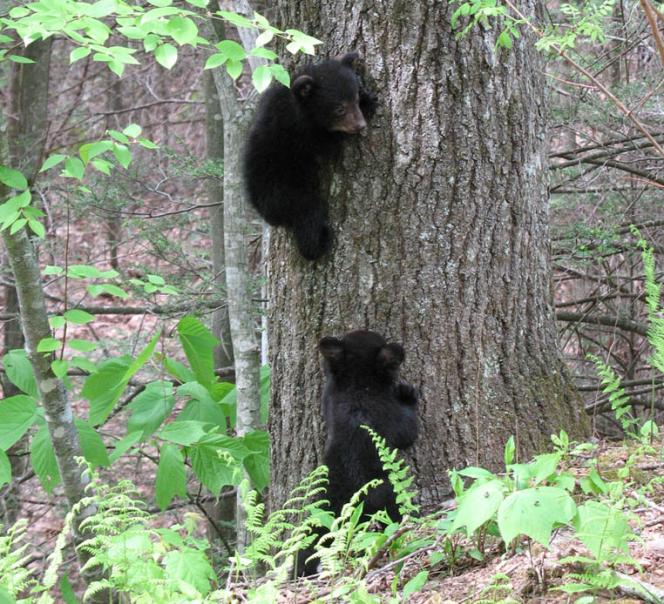
Along the A.T., or elsewhere in the George Washington and Jefferson National Forest, you’re visiting the home of wildlife like these adorable black bear cubs. Please respect their home and keep your distance!/U.S. Forest Service
Beyond The A.T.
That variety of experiences on the A.T. mirrors the larger potential for fun and discovery on the George Washington and Jefferson National Forest, where individuals can enjoy camping, mountain biking, hunting and fishing.
All four seasons are in abundance here, with the explosion of colors in the spring wildflowers challenged only by the flames of colors of the autumn leaves. Summer brings bears, deer, birds and a multiplicity of pollinators, while winter’s stillness is broken only by the crinkle of cracking ice cascades where frozen waterfalls shine in the sun.
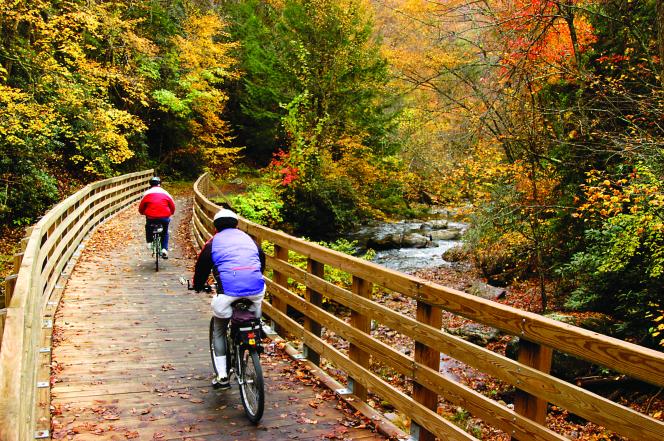
For trails beyond the A.T., the George Washington and Jefferson National Forest has well-maintained, multi-use trails like the Virginia Creeper Trail here in the Mount Rogers National Recreation Area/U.S. Forest Service)
And if you’re looking for trails beyond the A.T., the forest has plenty of options. There’s even trail-running, with ultramarathons like the three 100-milers that take place every year.
The highest point in Virginia, Mount Rogers, can be found here, as well as the very first Civilian Conservation Corps camp, NF-1 “Camp Roosevelt.” The Corps was responsible for many of the iconic public infrastructure projects of the Great Depression Era, including several campgrounds and facilities in the national forest.
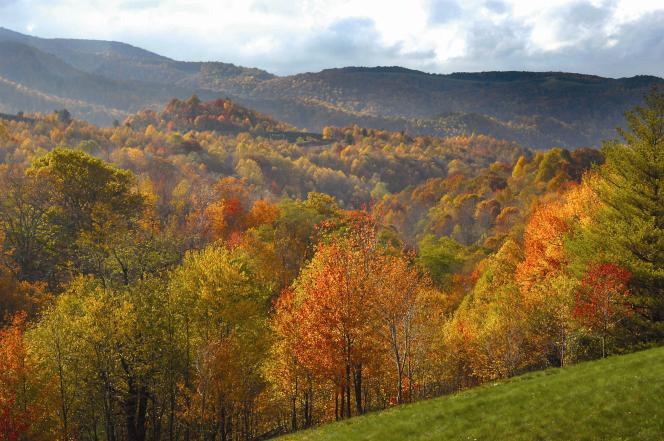
There’s no better place to enjoy fall than the George Washington and Jefferson National Forest. The colors at places like the Mount Rogers National Recreation Area can’t be beat/U.S. Forest Service
From The Tallgrass To The Forest
The Forest Service manages some of America’s best lands, lands that we maintain on behalf of and for the American people. The George Washington and Jefferson National Forest is just one of them, but like all the other national forests and grasslands, it’s special to those who live near and on it, who make their livelihoods from it, for whom it was their ancestral homelands, and even those who just stopped by for the day.
As Matthew Helt knows, even just that one day on the forest can be memorable.
“One of my favorite trail signs had a list of rules, the last rule was Smile and Have a Good Day,” Helt remembered fondly. “There is no better place to smile and appreciate that you live in the greatest place on Earth and you have the ability to hike this trail with all its history and culture. Get out there and support a local business, have a burger or beer after your hike and remember there’s no better day than a day on the A.T.”

 Support Essential Coverage of Essential Places
Support Essential Coverage of Essential Places






